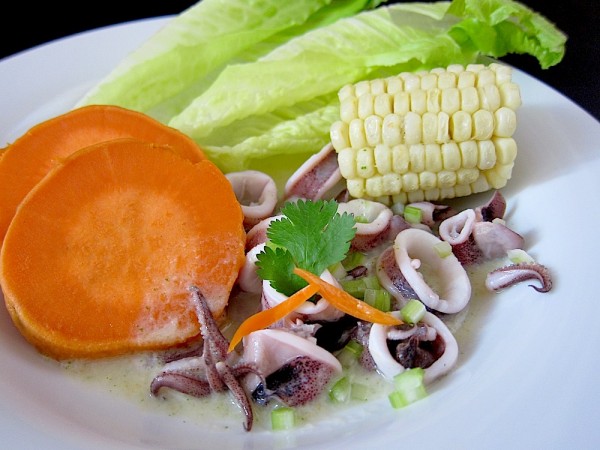Purists will tell you that only 5 ingredients are used in making a ceviche: fish, salt, hot peppers, onions, and lime juice. But what if you want to use squid instead of a firm flesh white fish? How do you cook the squid? And how do you make the leche de tigre sauce? The secret is to cook the squid and the leche de tigre separately, so that once combined the dish will be cool, spicy, and refreshing, just like the ocean in Peru.
In the traditional Ceviche de Pescado or even the Ceviche Nikkei, the leche de tigre sauce is a result of the lime juice and spices marinating with the fish for a few minutes. In this recipe, the squid is blanched and some of the squid is pureed in a fish stock together with cilantro, garlic, ginger, and habanero hot peppers to make a slighty creamy and milky leche de tigre with specks of green and orange.
The lime juice here does not cook the squid, but rather is added to the leche de tigre just before serving to give the dish added brightness while the celery garnish adds color and texture. The habanero garnish is a reminder of the must-have heat used in the leche de tigre. Served with lettuce, cooked sweet potato, and corn on the cob, there are strong rumors this dish will be making an appearance at my next Peruvian pop-up at 18 Reasons.
Special thanks to my dear friend visiting from Peru who helped me perfect this recipe over the past few days. It is a true pleasure to cook with someone who speaks the same culinary language and shares a profound love for the food from our home.
INGREDIENTS
- 1 lb squid
- 1/2 cup fish stock
- 4 cilantro leaves
- 1/4 teaspoon minced ginger
- 1/2 teaspoon minced garlic
- 1 teaspoon minced habanero pepper
- 1/2 lime
- 1 teaspoon minced celery for garnish
- 4 pieces julienned habanero for garnish
- 2 cilantro sprigs for garnish
In addition to the ingredients above, you’ll need a pot with water and a mesh strainer to cook the squid, measuring cups, and an immersion blender to prepare the leche de tigre.
PREPARATION
- Clean the squid tubes and separate into 3 equal groups by count.
- Remove the purple skin on the tubes from 1 of the groups, cut into thick rings and set aside. These white squid rings will be used for the leche de tigre sauce.
- Combine the other 2 groups, cut into thick rings, and set aside. These purple squid rings will be used for the 2 servings.
- Blanche the white squid rings by cooking for one minute in a pot with boiling water. Remove the squid rings from the pot using a mesh strainer and stop them from cooking by cooling with cold running water. Set aside and repeat with the purple squid rings.
- Mince the ginger and garlic. Remove the veins and seeds from the habanero pepper, mince 1 teaspoon of the pepper and julienne 4 pieces for garnish.
- Prepare the fish stock, and pour into a cup that can be used with an immersion blender. While the stock is still warm add 4 cilantro leaves and let steep for a few minutes.
- Add the minced ginger, garlic, habanero, and the white squid rings to the stock. Puree using an immersion blender.
- Pour the leche de tigre into a bowl, and add the blanched purple squid rings. Cover and refrigerate for 2 hours until ready to serve.
- Just before serving, add juice from 1/2 a lime to the leche de tigre and mix well.
- Serve 1/2 of the squid and leche de tigre on a plate with lettuce, cooked sweet potato and cooked corn. Garnish with minced celery, 2 pieces of julienned habanero and a sprig of cilantro.
YIELD
2 servings.
NOTES
This recipe is for fresh squid that needs to be cleaned. Once cleaned, the net weight will be less than 1 lb and probably between 1/2 lb and 3/4 lbs. Also, I removed the purple skin from 1/3 of the squid tubes to prevent the leche de tigre from having a purple color. If you use squid that already has been cleaned or has no purple skin you’ll need less than a lb and you won’t need to remove the purple skin. A good guideline is to measure the squid by volume once they have been blanched. About 1/4 cup of loosely packed squid is used for the puree, and 1/4 cup of loosely packed squid for each serving.
To make the fish stock, I used Better then Bouillon Fish Base, but made it more concentrated by using 1/2 cup of water to 1 teaspoon fish base. I also added the lime juice just before serving so that the citrus flavor is fresh, just like when making fish ceviche.
